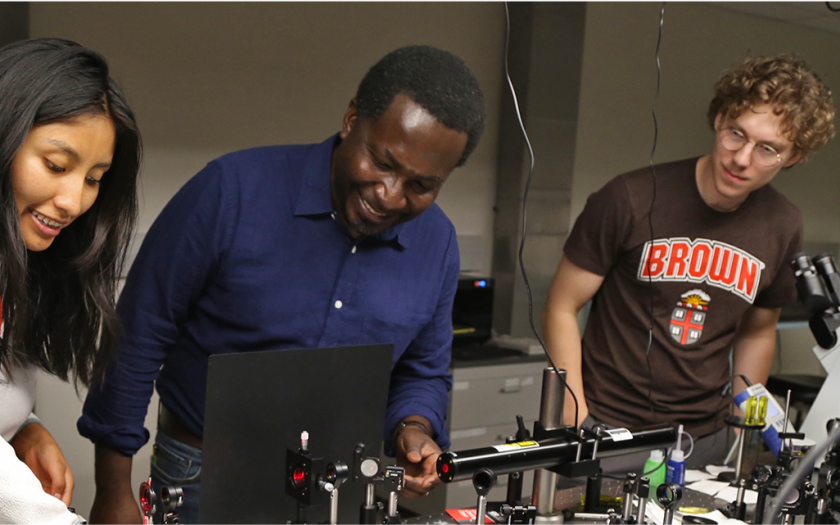Brown BME Spotlight: Mitchell Harling, Ph.D. Candidate

Mitchell Harling (right) with labmate Adriana C. Salazar Coariti (left) and his PI Dr. Kimani Toussaint (center).
Mitchell Harling is a Ph.D. student in Brown’s Biomedical Engineering program and a member of Dr. Kimani Toussaint’s PROBE Lab.
He received his B.S. in Biomedical Engineering from the University of Maine in May 2020. His previous research experience focused on the nonlinear optical imaging of the extracellular matrix (ECM) and subsequent image analysis to investigate ECM alterations in diseased states.
He has over six years of hands-on experience in optical physics research—driving laboratory output by publishing six peer-reviewed publications, eight conference papers, and presenting eight conference posters & one oral presentation. For recent publications, please see Mitchell's Google Scholar profile.
Outside of research, Mitchell plans to make an impact by developing and/or aligning with STEM outreach programs that are invested in engaging with historically underrepresented groups.
Let’s learn more about Mitchell from Mitchell himself…
What motivated you to choose Brown University for your doctoral studies?
I wasn’t considering Brown until the fall of my undergraduate senior year when I went to the BMES Conference and met Dr. Celinda Kofron. After chatting with her at the booth about my experience, research, and interest, she offered me an application fee waiver. I already had my materials prepared so it was an easy decision to apply at no charge.
Then, I met Dr. Vicki Colvin who visited my undergraduate institution—the University of Maine—to deliver a seminar. We talked about Brown’s direct match—about who may be a good fit for optics and light physics in Brown’s BME department. She mentioned Dr. Kimani Toussaint.
I wrote his name on the application. And I was accepted.
What solidified my decision to select Brown for my doctoral studies was the in-person accepted students' day visit: “It was that day that changed my mind…it’s why I’m here today.” It was a purposeful event showcasing what you may do at Brown and with whom you may work: “People were nice…and I think that’s important. People seemed happy…that went far with me.”
Dr. Toussaint and I talked for at least an hour about our research and our lives. We had an impactful conversation and, at that point, “it was a gut feeling…this is the right place for me.”
Now, I’m in my fourth year and I’m happy with my decision.
Brown University is known for its flexible interdisciplinary approach. What’s your experience collaborating with researchers from outside your lab? Can you give an example?
I haven’t had many opportunities to collaborate in my research with other faculty and students outside of my lab here at Brown.
We have a collaborator whom we work closely with at the University of Central Florida. We have had great success together.
Outside of my research, I have been able to collaborate with people. For instance, Dr. Toussaint along with other faculty and community members led a two-day event in 2022 called: Home Health Technologies in 2032. Together—faculty from Brown and other institutions, Brown staff, local nurses, folks with geriatric care experience, and members of the RI & Boston communities—we all looked ahead to consider what is this technology going to be like: “There were some great conversations…I was lucky to be a part of that and help with the organizing aspect…working closely with people who may not be scientists or may not be engineers—like me—and I learned a lot from that experience.” I appreciated the space to dialogue with end-users, expanding the conversation beyond scientists.
Who has played a significant role in shaping your academic journey?
My undergraduate advisor, Dr. Karissa Tilbury at the University of Maine, played a significant role in my academic journey.
When I was a first-year undergraduate student in the Biomedical Engineering program there, I asked her if I could work in her lab as a Research Assistant: “I was actually the first student, in general, to work in that lab because it was a brand new lab…she allowed me to get hands-on experience not just in lab work but building a lab, as well. That shaped why I’m here today and the things that I want to do.”
As a mentor, Dr. Tilbury was effective because she was practical and encouraging: “She made me feel like the world is my oyster…encouraging me to dig deep…treating me with great respect…that made me continue with the academic journey.”
What do you like to do outside the lab?
I picked up indoor rock climbing in the last few years. I enjoy going to the movies. I like to read—which is hard to do as a Ph.D. student because you’re already reading a lot but it’s fun to read for pleasure, too. And, of course, hang out with my friends and my cats—Brick and Mortar.
What question do you wish we had asked?
As a senior Ph.D. student, I want to offer advice for incoming students:
- Practice patience. Patience is important. You’ll be here for at least four years, generally.
- Value values. Don’t compromise your morals and ethics to advance your work. I don’t expect that to happen at Brown, it certainly isn’t my experience, but it’s not uncommon for graduate students.
- Seek connection. It can be a lonely experience and there are a lot of people around you in similar situations. You can make friends if you put yourself out there.
Remember: “When it’s over, it’ll be worth it.”